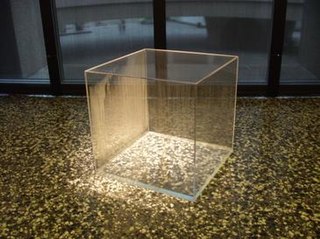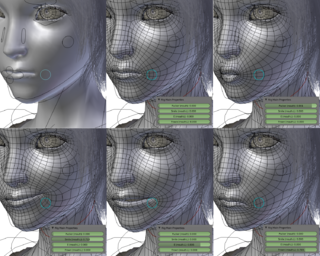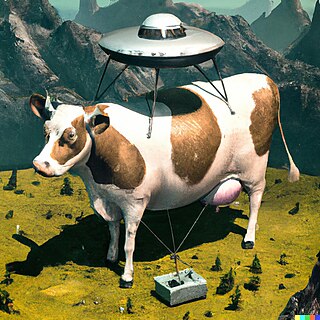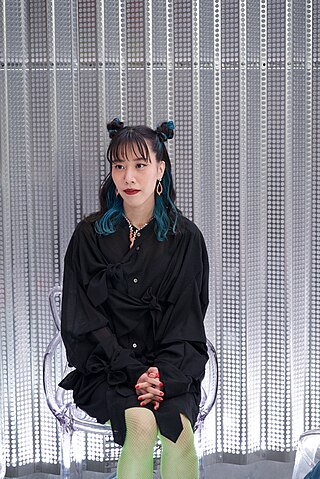
Digital art refers to any artistic work or practice that uses digital technology as part of the creative or presentation process. It can also refer to computational art that uses and engages with digital media.

Christie's is a British auction house founded in 1766 by James Christie. Its main premises are on King Street, St James's in London, and it has additional salerooms in New York, Paris, Hong Kong, Milan, Amsterdam, Geneva, Shanghai, and Dubai. It is owned by Groupe Artémis, the holding company of François Pinault. In 2022 Christie's sold US$8.4 billion in art and luxury goods, an all-time high for any auction house. On 15 November 2017, the Salvator Mundi was sold at Christie's in New York for $450 million to Saudi Prince Badr bin Abdullah bin Mohammed bin Farhan al-Saud, the highest price ever paid for a painting.

Generative art is post-conceptual art that has been created with the use of an autonomous system. An autonomous system in this context is generally one that is non-human and can independently determine features of an artwork that would otherwise require decisions made directly by the artist. In some cases the human creator may claim that the generative system represents their own artistic idea, and in others that the system takes on the role of the creator.
Computer art is art in which computers play a role in the production or display of the artwork. Such art can be an image, sound, animation, video, CD-ROM, DVD-ROM, video game, website, algorithm, performance or gallery installation. Many traditional disciplines are now integrating digital technologies and, as a result, the lines between traditional works of art and new media works created using computers has been blurred. For instance, an artist may combine traditional painting with algorithm art and other digital techniques. As a result, defining computer art by its end product can thus be difficult. Computer art is bound to change over time since changes in technology and software directly affect what is possible.

Human image synthesis is technology that can be applied to make believable and even photorealistic renditions of human-likenesses, moving or still. It has effectively existed since the early 2000s. Many films using computer generated imagery have featured synthetic images of human-like characters digitally composited onto the real or other simulated film material. Towards the end of the 2010s deep learning artificial intelligence has been applied to synthesize images and video that look like humans, without need for human assistance, once the training phase has been completed, whereas the old school 7D-route required massive amounts of human work .
Music and artificial intelligence is the development of music software programs which use AI to generate music. As with applications in other fields, AI in music also simulates mental tasks. A prominent feature is the capability of an AI algorithm to learn based on past data, such as in computer accompaniment technology, wherein the AI is capable of listening to a human performer and performing accompaniment. Artificial intelligence also drives interactive composition technology, wherein a computer composes music in response to a live performance. There are other AI applications in music that cover not only music composition, production, and performance but also how music is marketed and consumed. Several music player programs have also been developed to use voice recognition and natural language processing technology for music voice control. Current research includes the application of AI in music composition, performance, theory and digital sound processing.

26 October 1993 is an artwork created in 1993 as a collaboration between English artists Henry Bond and Sam Taylor-Wood, both of whom were involved in the Young British Artists scene of contemporary art. It is a pastiche or remaking of a well-known photographic portrait of John Lennon and Yoko Ono that was made by Annie Leibovitz a few hours before Lennon's murder.

WikiArt is a visual art wiki, active since 2010.
In computational learning theory, Occam learning is a model of algorithmic learning where the objective of the learner is to output a succinct representation of received training data. This is closely related to probably approximately correct (PAC) learning, where the learner is evaluated on its predictive power of a test set.

A generative adversarial network (GAN) is a class of machine learning frameworks and a prominent framework for approaching generative AI. The concept was initially developed by Ian Goodfellow and his colleagues in June 2014. In a GAN, two neural networks contest with each other in the form of a zero-sum game, where one agent's gain is another agent's loss.

StyleGAN is a generative adversarial network (GAN) introduced by Nvidia researchers in December 2018, and made source available in February 2019.

Artificial intelligence art is any visual artwork created through the use of an artificial intelligence (AI) program.
Synthetic media is a catch-all term for the artificial production, manipulation, and modification of data and media by automated means, especially through the use of artificial intelligence algorithms, such as for the purpose of misleading people or changing an original meaning. Synthetic media as a field has grown rapidly since the creation of generative adversarial networks, primarily through the rise of deepfakes as well as music synthesis, text generation, human image synthesis, speech synthesis, and more. Though experts use the term "synthetic media," individual methods such as deepfakes and text synthesis are sometimes not referred to as such by the media but instead by their respective terminology Significant attention arose towards the field of synthetic media starting in 2017 when Motherboard reported on the emergence of AI altered pornographic videos to insert the faces of famous actresses. Potential hazards of synthetic media include the spread of misinformation, further loss of trust in institutions such as media and government, the mass automation of creative and journalistic jobs and a retreat into AI-generated fantasy worlds. Synthetic media is an applied form of artificial imagination.
The Fréchet inception distance (FID) is a metric used to assess the quality of images created by a generative model, like a generative adversarial network (GAN). Unlike the earlier inception score (IS), which evaluates only the distribution of generated images, the FID compares the distribution of generated images with the distribution of a set of real images. The FID metric does not completely replace the IS metric. Classifiers that achieve the best (lowest) FID score tend to have greater sample variety while classifiers achieving the best (highest) IS score tend to have better quality within individual images.

Michael Joseph Winkelmann, known professionally as Beeple, is an American digital artist, graphic designer, and animator known for selling NFTs. In his art, he uses various media to create comical, phantasmagoric works that make political and social commentary while using pop culture figures as references. British auction house Christie's has called him "A visionary digital artist at the forefront of NFTs". Beeple was introduced to NFTs in October 2020 and credits Pak for providing his first "primer" on selling NFTs. The NFT associated with Everydays: the First 5000 Days, a collage of images from his "Everydays" series, was sold on March 12, 2021, for $69 million in cryptocurrency to an investor in NFTs. It is the first purely non-fungible token to be sold by Christie's. The auction house had previously sold Block 21, an NFT with accompanying physical painting for approximately $130,000 in October 2020.

Artbreeder, formerly known as Ganbreeder, is a collaborative, machine learning-based art website. Using the models StyleGAN and BigGAN, the website allows users to generate and modify images of faces, landscapes, and paintings, among other categories.

Midjourney is a generative artificial intelligence program and service created and hosted by the San Francisco–based independent research lab Midjourney, Inc. Midjourney generates images from natural language descriptions, called prompts, similar to OpenAI's DALL-E and Stability AI's Stable Diffusion. It is one of the technologies of the AI boom.

Emi Kusano is a Japanese multidisciplinary artist based in Tokyo. She is recognized for her integration of artificial intelligence into retro-futuristic artwork. In a collaboration with Christie's New York, an auction house, and Gucci, she unveiled an AI-generated 3D dress.














